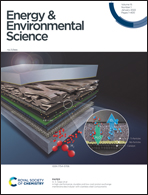A finely regulated quantum well structure in quasi-2D Ruddlesden–Popper perovskite solar cells with efficiency exceeding 20%†
Abstract
The development of quasi-two-dimensional (2D) Ruddlesden–Popper phase perovskite solar cells (PSCs) has significantly improved the stability of the devices. However, the presence of quantum confinement effects and insulating spacer cations in 2D perovskite films will widen the bandgap and hinder carrier transport, thereby discounting the efficiency of 2D PSCs. Here, a quantum well reversely graded structure is introduced into FA-MA mixed 2D perovskite films via isopropanol washing. 2D perovskites, mainly the n = 2 phase, are concentrated at the top of the film. We find that half of the spacer cations are washed away by isopropanol, and the average n-value evolves from 5 in the precursor to about 18 in the final annealed film. As a result, the quantum confinement effect inside the film is weakened, and the external quantum efficiency response wavelength is extended to 812 nm. More importantly, the film shows out-of-plane orientation, an enlarged apparent grain size (688 nm), and a long carrier lifetime (936 ns). A record-high power conversion efficiency (PCE) of 20.12% is achieved. The unencapsulated device retains 98% of its initial PCE after aging at 30 ± 5% relative humidity for 2000 h, and 96% after continuous operation at the maximum power point for 360 h. The fine regulation of quantum wells can be the answer to highly efficient and highly stable PSCs.



 Please wait while we load your content...
Please wait while we load your content...